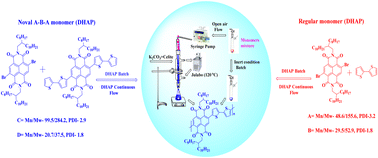Direct (hetero)arylation (DHAP) polymerization of conjugated polymers – new A–B–A monomer design for P(NDI2OD-T2) & the challenges of adopting DHAP for continuous flow processes†
Abstract
P(NDI2OD-T2), also known as Polyera ActivInk N2200, was synthesized by the atom-economic direct hetero arylation polymerization (DHAP) route using a newly designed A–B–A monomer. The new monomer design involved flanking naphthalene diimide with bithiophene units in the bay position, which was further polymerized with bay substituted 1,4-dibromo naphthalene diimide, to afford the same polymer structure as P(NDI2OD-T2). The new monomer design resulted in a very high molecular weight (Mn: 99.5 kDa, ĐM: 2.8) defect-free polymer in a quantitative yield by the DHAP batch process using 1,2,4-trichlorobenzene (TCB) as the solvent. DFT studies revealed that the abstraction of the α-proton from the naphthalene diimide substituted 2,2′-bithiophene was favorable by 2.6 kcal mol−1 (ΔΔG) as compared to that from 2,2′-bithiophene. The reason for this improved C–H activation at the α position can be attributed to the presence of C–H⋯π stabilizing interactions in naphthalene diimide substituted 2,2′-bithiophene, which strengthens upon the extended charge delocalization throughout the ring, thus stabilizing the conjugate base generated after the proton abstraction. Continuous flow polymerization was carried out by pumping the DHAP reaction mixture including the monomers, catalyst, and additive (pivalic acid) solubilized in degassed TCB through a pre-heated glass condenser packed with K2CO3 and Celite under aerobic conditions. Reproducible molecular weights of Mn: 29.5 kDa, ĐM: 1.7 were obtained at much lower concentrations of reactant mixture compared to that for batch polymerization. This is the first report of the synthesis of P(NDI2OD-T2) by a Continuous Flow Process adopting the DHAP route to obtain a defect-free polymer with reasonable molecular weights. P(NDI2OD-T2) was also synthesized by Stille polymerization as a reference control sample to compare the thermal and charge carrier transport properties of the DHAP polymers. Organic field-effect (OFET) mobility measurements indicated mobility values in the order of 10−3 cm2 V−1 s−1 for the DHAP batch polymer (using the novel monomer design). The P(NDI2OD-T2) synthesized by DHAP batch using the commonly used starting materials – bisbromo naphthalene diimide and bithiophene, exhibited OFET mobilities which were one order less, ∼10−4 cm2 V−1 s−1. This observation highlights the importance of structural design in the monomer to enhance reactivity and thereby the bulk properties using the DHAP route.

- This article is part of the themed collection: Journal of Materials Chemistry C HOT Papers


 Please wait while we load your content...
Please wait while we load your content...